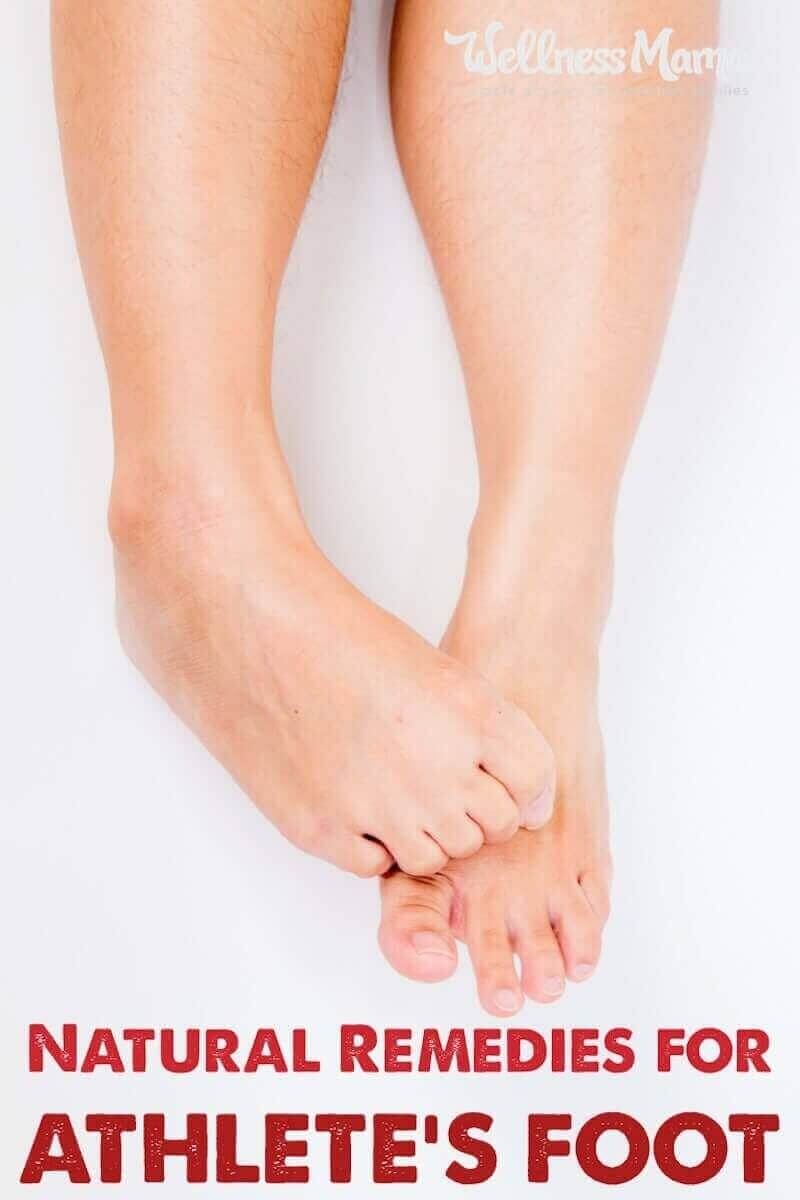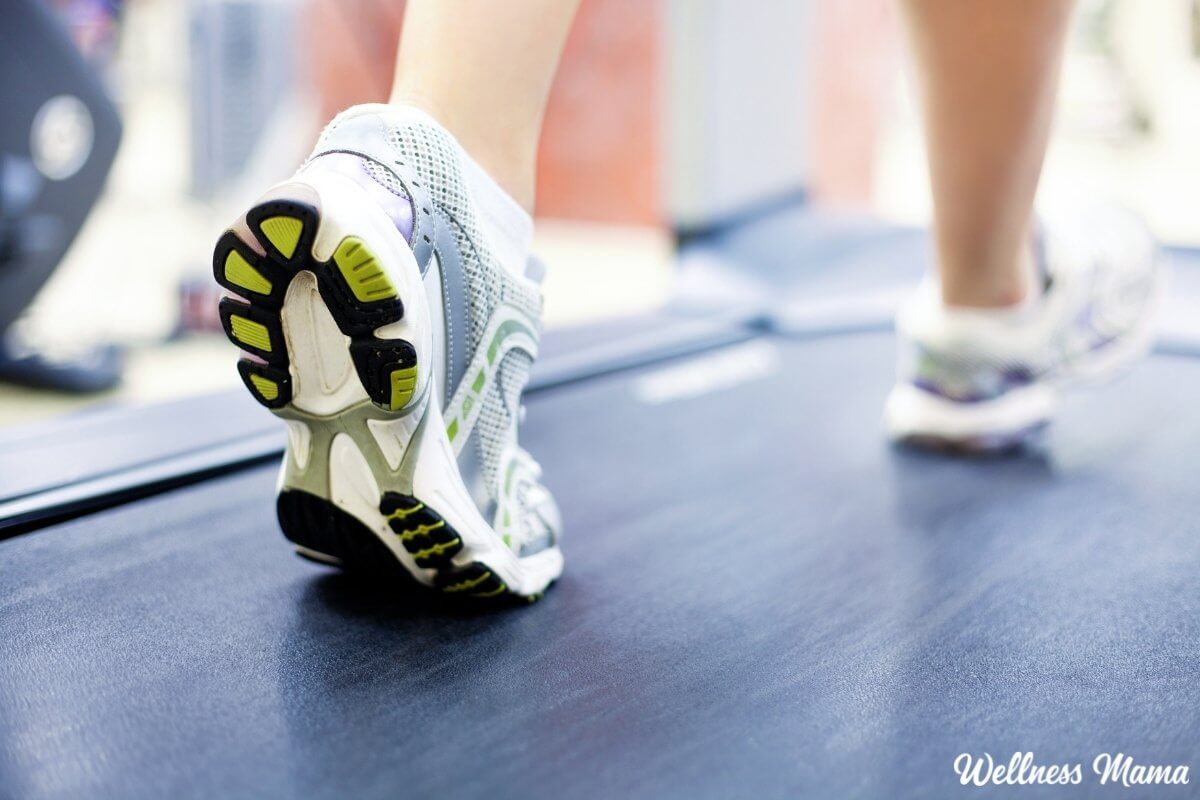It’s no secret that we’re all about natural remedies around here. Every mom should have a few tricks up her sleeve for remedying minor ailments at home without resorting to harmful chemicals. Here are five natural remedies for a pesky problem that has ailed many of us from time to time… icky, peeling athlete’s foot!
What Is Athlete’s Foot?
Athlete’s foot is the skin condition most often associated with stinky, sweaty feet and gym locker rooms. However, it doesn’t just affect athletes. From your husband to your kids to — yep, you — athlete’s foot can strike anyone.
How Does Athlete’s Foot Occur?
It may be surprising to learn that athlete’s foot isn’t just something that teenage boys catch. In fact, there is more to the root cause of athlete’s foot than infected showers or towels.
The body’s microbiome may actually have a lot to do with susceptibility to any infection, including athlete’s foot. Let’s first look at what really causes athlete’s foot.
What Leads to Athlete’s Foot
- Coming into contact with infected people or items, like towels, a shower floor, or a swimming pool
- Wearing tight, damp shoes
- Overall bodily microbiome imbalance
- Poor immune system function
So, while exposure to the fungus responsible for athlete’s foot (called tinea) promotes the spread of the infection, your own personal health may have a lot to do with how your body handles an exposure. When we have an overgrowth of harmful bacteria and fungi, we are more susceptible to infections of all kinds.
We have more bacterial cells than human cells, and it truly is all about the bacterial balance. I talk a lot about gut health and the importance of supporting the skin microbiome. The idea is that when your inner ecosystem is balanced, your whole body microbiome will be balanced, including the bacteria on and under the surface of your skin.
Symptoms of Athlete’s Foot
Athlete’s foot can actually mimic bad eczema or dermatitis, so it can be hard to differentiate between the two. Symptoms include:
- Thick, red, scaly, or cracking skin
- Itchy rash
- Symptoms concentrated between the toes, where fungus is more likely to grow
- Blisters
- Discolored toenails
How to Avoid Athlete’s Foot in the First Place
The best remedy is often avoiding the problem in the first place. Here are some ways to reduce the chances of athlete’s foot:
- Wear foot coverings in wet public places, when possible.
- Dry feet well when getting out of water, whether at home or in public places.
- Wash towels if you suspect infection or if they’ve been used in a public place.
- Mind your microbiome by eating a healthy diet, supplementing probiotics, and avoiding good bacteria-killing products like antibacterial soaps. (Read about how to mind your gut and overall health here.)
Five Natural Remedies for Athlete’s Foot
In the unfortunate event of getting this dreaded fungal foot infection, there are some great natural remedies that may help get it under control:
1. Internal Probiotic Remedy
Gut health affects so many aspects of overall health! Ramp up probiotics, avoid sugar and excessively starchy foods, and focus on nourishing foods like bone broth and sauerkraut.
Those who frequently battle infections, whether athlete’s foot or the common cold, may have an underlying gut issue. Our immune systems are responsible for fighting off infections, and while the occasional cold or flu gives them the workout they need to stay strong, fungal infections are more a symptom of imbalance. When our guts are imbalanced, our immune systems become weakened, and we become susceptible to infections.
Candida is a type of fungal yeast and is often at the root of lots of health conditions like eczema, arthritis, and allergies. While it is a natural strain that is found in everyone’s guts, problems arise when it becomes overgrown due to lack of beneficial bacteria. Doing a diet like the GAPS diet can help to eliminate harmful fungi and bring the gut back into balance.
Likewise, tinea fungus (the fungus responsible for athlete’s foot) is normal to have on the skin. However if our skin bacteria is out of balance, then our skin is more susceptible to infections.
Not only is it necessary to bring the gut bacteria into balance, but it may also be beneficial to balance the bacteria (microbiome) on the skin. (To learn more about nurturing the skin’s microbiome, check out this podcast.)
2. Topical Probiotic Remedy
While oral probiotics are beneficial to your gut and overall health, in the event of an acute athlete’s foot infection, you may find topical application of probiotics helpful.
Let’s take the same idea as this recipe for my probiotic face mask and make it the base for a natural remedy for athlete’s foot.
Mix together:
- 1 TBSP plain organic yogurt (full fat preferred)
- 1 capsule of saccharomyces boulardii (a beneficial yeast that has been shown to battle pathogenic species of fungi)
Use a cotton ball to spread the mixture onto the infected areas and allow to sit for about half an hour. Increase or double the amounts if necessary.
3. Apple Cider Vinegar Remedy
The sour, tangy crunchy mama favorite that helps with everything from heartburn to dandruff can also be one of the best natural remedies for mild athlete’s foot.
Apple cider vinegar (ACV for those familiar with this crushed, fermented apple product) has been used since the times of Hippocrates, when it was prized for its medicinal properties. It’s known to be especially beneficial against yeast and fungus, and many people take it internally to keep candida in balance.
To use ACV to remedy athlete’s foot, make sure you’ve got a good, high-quality, unpasteurized version (the ones still containing the “mother” are better, and you can even make your own!). Of course, you can also buy in stores or online through Amazon. I also love and use this brand.
In a foot bath container, mix together:
- 2 cups of water
- 1/2 cup of apple cider vinegar
Soak your feet for around half an hour. You can also apply plain ACV directly to the infection with a cotton ball. Apple cider vinegar will likely sting, so be aware and dilute more if necessary.
4. Essential Oil Remedies
There are a few essential oils that can be used to battle fungal infections, and skin conditions are one of my favorite uses of essential oils.
Anti-fungal essential oils include:
- tea tree
- lavender
- oregano
- thyme
- geranium
- clove
There are several ways you can use essential oils as natural remedies for athlete’s foot.
How to make your own salve:
Use this simple recipe for homemade healing salve to create your own anti-fungal salve by adding anti-fungal essential oils.
Important Note: Apply neat or diluted. Whether or not you use essential oils directly on the skin or dilute them is a personal and sometimes hotly debated choice. Because essential oils are highly concentrated, it is generally not suggested to use them directly on the skin.
However, some essential oils may be ok to apply neat, or directly on the skin, including lavender. The biggest concern in this case is applying the oil to broken skin, which would be painful and could cause further irritation. You can always check with a certified aromatherapist if you’re interested in using essential oils undiluted.
Otherwise, a good rule of thumb is 3-5 drops of essential oils per teaspoon of oil. Coconut oil is an excellent choice because it is also anti-fungal. Just combine any of the above anti-fungal essential oils with some coconut oil and apply to the infected areas.
Make an anti-fungal spray:
Combine anti-fungal essential oils with witch hazel to create a cleansing, healing astringent. Combine oils of choice in a spray bottle with witch hazel, keeping in mind dilution ratios, spritz on clean, dry feet, and then allow to dry. You could also kill two birds with one stone and add a little ACV to the spray.
Try neem oil
A 2011 study found neem extracts to be effective at killing off different forms of candida, fungi, and mold, which are possible root causes of Athlete’s foot. However, this study was done in Petri dishes, not on animals or humans. Since I already use neem oil as an essential oil carrier oil, I’m comfortable adding some to this remedy.
5. Remedies for Footwear and Towels
It turns out sticking your sneakers in the freezer for about 24 hours may kill the fungus and prevent it from growing further. Additionally, you could use an anti-fungal essential oil spray like the one suggested above to spritz your sneakers and kill the fungus.
In addition to disinfecting your shoes, it is also a good idea to toss or disinfect any socks worn while infected, plus disinfect towels used.
To disinfect towels, wash on the hottest setting on the washing machine. Add anti-fungal essential oils, vinegar, or hydrogen peroxide to kill germs. In cases of persistent or recurrent athlete’s foot infections, consider throwing away items that may have come in contact with the fungus.
You Can Remedy Athlete’s Foot Naturally!
Most minor infections can be remedied at home without using harmful or toxic over-the-counter or prescription drugs. Athlete’s foot is no exception, and with these natural remedies for athlete’s foot, you’ll be fungus-free in no time!
This article was medically reviewed by Cynthia Thurlow, NP, the CEO and founder of the Everyday Wellness Project, nurse practitioner, international speaker, and globally recognized expert in intermittent fasting and nutritional health. As always, this is not personal medical advice and we recommend that you talk with your doctor.
Have you tried any of these natural remedies for athlete’s foot? Which has worked?




Leave a Reply